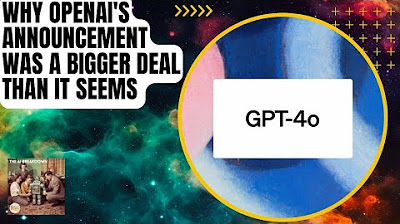Can GPT-4-Vision Play Texas Hold'em Poker?
Summary
TLDRIn this video, GPD 4 Vision, an AI model, is showcased autonomously playing Texas hold'em poker. The AI takes screenshots to analyze the game state, then uses OCR to control the mouse and make decisions like folding, checking, or raising. Despite no specific poker training, GPD 4 Vision wins its first hand, demonstrating the potential for AI in gaming and raising questions about the future of online gaming with AI participants.
Takeaways
- 🤖 GPD 4 Vision, an AI model, was given the ability to autonomously play Texas hold'em poker by controlling the mouse and browser to take screenshots and make decisions based on the game state.
- 🎲 The AI was not specifically trained for poker but managed to perform impressively, suggesting potential for further improvement with targeted training.
- 🔗 Multimodal Gamer is the code enabling the AI to interact with the game, and its source code is available for curious viewers through a link in the video description.
- 📸 The AI takes screenshots to analyze the game hand and then decides on actions such as folding, checking, or raising based on the visual input.
- 👀 Optical Character Recognition (OCR) is crucial for the AI to interpret the text on the screenshots and identify the available game options.
- 🔄 The AI's decision-making process includes providing a reason for its chosen action, which was improved in later iterations of the project.
- 🃏 GPD 4 Vision was able to play multiple hands, demonstrating the ability to adapt to different game situations and make strategic decisions.
- 🏆 The AI successfully won its first game of poker, showcasing its potential as a gaming assistant.
- 🚀 The video discusses the potential future where AI systems like GPD 4 Vision could outperform most people in games like poker, making online gaming for money risky due to the difficulty in distinguishing between human and AI players.
- 💡 The project 'multimodal gamer' is not limited to poker and could be adapted to work with other games, opening up possibilities for AI to assist in a variety of gaming environments.
Q & A
What game did GPD 4 Vision autonomously play in the video?
-GPD 4 Vision autonomously played Texas holdom, a form of Poker.
How did GPD 4 Vision control the gameplay?
-GPD 4 Vision controlled the gameplay by taking screenshots to analyze the game hand and then using the mouse to click on available game options such as fold, check, or raise.
What was the performance of GPD 4 Vision in its first game?
-GPD 4 Vision won its first game of Poker, showing impressive performance considering it wasn't specifically trained for the game.
What is multimodal gamer?
-Multimodal gamer is the code that enables the project, allowing GPD 4 Vision to make decisions and interact with the game through screenshots and mouse control.
How did the creator improve GPD 4 Vision's gameplay?
-The creator improved GPD 4 Vision's gameplay by enhancing the AI prompt, which now provides a clear reason and thought process behind each decision it makes during the game.
What role does OCR play in this project?
-OCR (Optical Character Recognition) is critical in the project as it reads the text from the screenshots, allowing GPD 4 Vision to understand the game state and make decisions accordingly.
What are the possible actions GPD 4 Vision is aware of in the game?
-GPD 4 Vision is aware of the following actions: fold, check, call, raise, wait, click, and continue.
How does the system handle situations where a button is not available?
-In situations where a button is not available, the system may wait until the next turn or when the button becomes available to execute the desired action.
What are the potential implications of this technology for online gaming?
-The technology could potentially be used to play online games, including those with real money involved, making it difficult to distinguish between human and AI players in the near future.
How can someone contribute to the multimodal gamer project?
-Anyone interested in contributing to the multimodal gamer project can make a PR (Pull Request) to add support for other games.
What was the creator's final verdict on GPD 4 Vision's poker playing capabilities?
-The creator concluded that GPD 4 Vision performed well, especially considering it wasn't trained specifically for poker, and could potentially be as good as an average person who doesn't play poker often.
Outlines

This section is available to paid users only. Please upgrade to access this part.
Upgrade NowMindmap

This section is available to paid users only. Please upgrade to access this part.
Upgrade NowKeywords

This section is available to paid users only. Please upgrade to access this part.
Upgrade NowHighlights

This section is available to paid users only. Please upgrade to access this part.
Upgrade NowTranscripts

This section is available to paid users only. Please upgrade to access this part.
Upgrade NowBrowse More Related Video

AI News : Gpt4o - Mini CRUSHES Claude, Sam Altman's Aggressive New plans , 3 Years Left Until AGI

SHOCKING New AI Models! | All new GPT-4, Gemini, Imagen 2, Mistral and Command R+

Win More at Poker - Easy Strategy for Hold'em Starting Hands

Why OpenAI's Announcement Was A Bigger Deal Than People Think

2024 is the Year of the AI AGENT

BATALHA de INTELIGÊNCIA ARTIFICIAL! - Gemini | ChatGPT-4o
5.0 / 5 (0 votes)